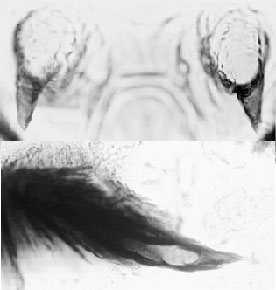C. 'jacksoni' pupa Pupa is also typical of the C. oppositus-group. Body relatively dark, shagreen of tergites covering most of TII-VII, only anterior of TVIII and very light on TIX.
Length: Females are larger than males which is reflected in many characters: Female about 8.8 (7.52-8.2) mm, Male 7.51 (7.24-7.97); inner margin of wing case also longer in female 1.83 (1.63-2.11) mm; male 1.55 (1.4-1.65) mm. Cephalic tubercles again larger in females - 119-123 µm high and 1.23-1.35 times higher than width at base - than males 79-84 and 0.80-0.94 times higher than wide. Length of the female antennal case 85.3 (0.81-0.89) µm. No secondary tubercle or frontal warts.
Respiratory base abt 136.5 (147-153) x 55.3 (38-68) µm, only slightly constricted at midpoint; HR 2.24-3.30.
Abt 54-110 (higher values in females - mean 94 cf. 60 for males) recurved hooks at base of segment II, width of hook row abt 735 µm, width segment about 1.22 mm, so hook row covers about 0.6 of segment width (data for females only).
Pedes spurii B on seg. II obvious, less so for seg. III; pedes spurii A on seg. IV abt. 170 (142-198) µm long, or 0.21 (0.17-0.24) of the segment length.
Mostly only one spine or two spines on one side, but 3 seen on one female, on the spur of segment VIII and about 108 (84-148) taeniae on anal fin, again higher values are for females. 
Pupal cephalic tubercles (above) and spur (below) of C. 'jacksoni'[ Return to Index| Go to C. 'jacksoni' immatures ]Created: 11 March 2024
Access: Unrestricted
Copyright © 2024, Jon Martin.
|

